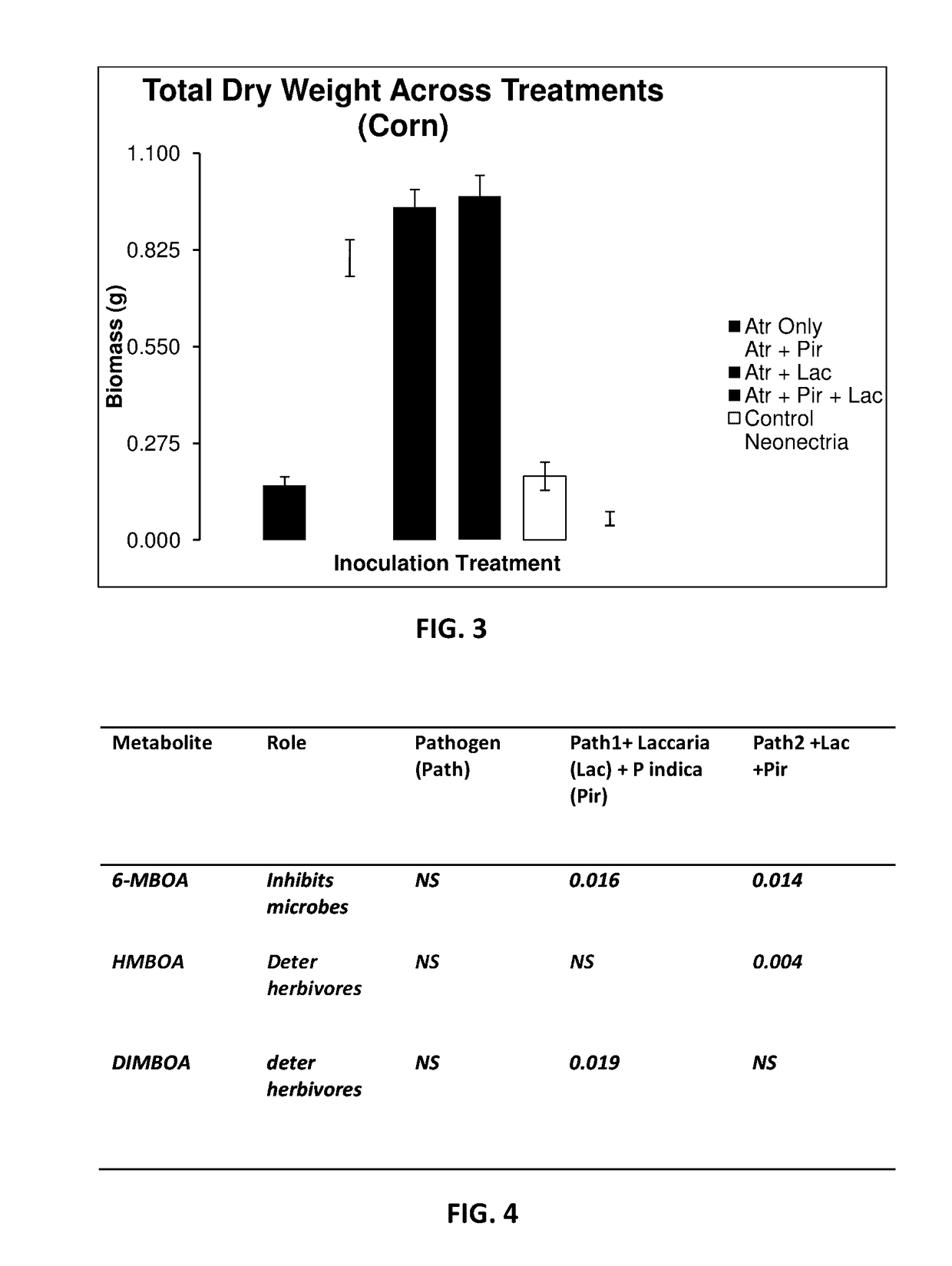Complex of mutualistic microbes designed to increase plant productivity
a mutualistic microbe and complex technology, applied in the field of complex of mutualistic microbes designed to increase plant productivity, can solve the problems of reducing the yield of many crops, affecting plant growth, and affecting the health of people,
- Summary
- Abstract
- Description
- Claims
- Application Information
AI Technical Summary
Benefits of technology
Problems solved by technology
Method used
Image
Examples
example 1
[0064]Root Colonization Rates of Different L. bicolor Strains on Different Poplar Genotypes
[0065]Materials and Methods: Root Colonization Measurements: The percentage of mycorrhizal colonization, as described by Tagu et al. (Variation in the ability to form ectomycorrhizas in the Fl progeny of an interspecific poplar (Populus spp.) cross. Mycorrhiza 10:237-240, 2001) was determined three-and-a-half months after inoculation by eight observers. All the observers observed randomly the plants within eight blocks and block after block. Each root system was rinsed with tap water, cut in 1-cm pieces and analyzed under a dissecting microscope. For each root system, 100 apices were randomly examined and assessed as mycorrhizal or non-mycorrhizal.
[0066]Different poplar genotypes (particularly poplar genotype 52 225 (P. deltoides), poplar genotype D124 (hybrid TXD), poplar genotype ILL 101 (hybrid TXD) and poplar genotype 93 968 (P. trichocarpa) were treated with various L. bicolor strains (pa...
example 2
[0068]Pseudomononas Strain GM41 Assists L. bicolor in Promoting P. trichocarpa Growth
[0069]Materials and Methods: Various L. bicolor strains (particularly Lb 445.79, Lb 559.96, Lb 594.96, Lb 560.89, Lb 669.97, Lb 561.97, and Lb S238N) were applied to P. trichocarpa plants between 5-10% volume ratio alone or in combination with 5 ml / L of Pseudomonas fluorescens GM41 102 CFU / ml. The soil was treated using 5 L / m2 of the mixture (i.e. 5 liters of PMB per 1 m2 of soil).
[0070]Results: GM41 increased the growth of P. trichocarpa plants in combination with all L. bicolor strains tested (FIG. 2). Lb S238N strain promoted P. trichocarpa growth the most, both alone and in combination with GM41 (FIG. 2).
example 3
[0071]Proprietary Microbial Blend (PMB) Comprising L. bicolor and P. indica Promotes Plant Growth Even in the Presence of Pathogens
[0072]Materials and Methods: The dikaryotic mycelium of L. bicolor S238N used in this study was grown and maintained in Petri dishes containing Pachlewski agar medium P5 (Di Battista et al., 1996) and incubated at 25° C. for 3 week.
[0073]Experiments have been performed using fungal inocula grown in soil / medium mixture or millet before co-culture with plants. At the time of the co-culture with the plants, sterile potting soil has been mixed Volume to Volume with the fungal inoculum. For example, 5% Volume of inoculum to Volume of soil mixture means that 50 ml of the fungal soil has been mixed with 950 ml of sterile soil to grow the plant.
[0074]Results: Application of PMB, comprising a mixture of Piriformispora indica in combination with Laccaria bicolor at 5% volume to volume ratio, equivalent to 1 L / m2 of inoculum at a concentration of 5 cells / g final so...
PUM
| Property | Measurement | Unit |
|---|---|---|
| volume | aaaaa | aaaaa |
| volume | aaaaa | aaaaa |
| volume | aaaaa | aaaaa |
Abstract
Description
Claims
Application Information
 Login to View More
Login to View More - R&D
- Intellectual Property
- Life Sciences
- Materials
- Tech Scout
- Unparalleled Data Quality
- Higher Quality Content
- 60% Fewer Hallucinations
Browse by: Latest US Patents, China's latest patents, Technical Efficacy Thesaurus, Application Domain, Technology Topic, Popular Technical Reports.
© 2025 PatSnap. All rights reserved.Legal|Privacy policy|Modern Slavery Act Transparency Statement|Sitemap|About US| Contact US: help@patsnap.com



